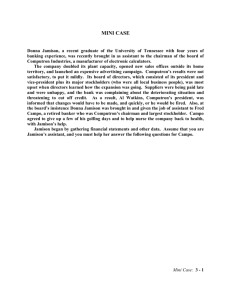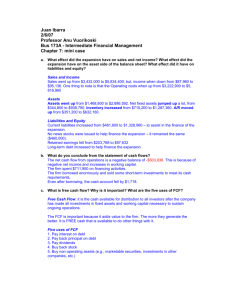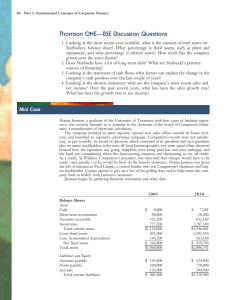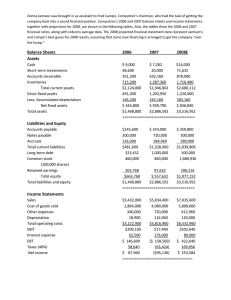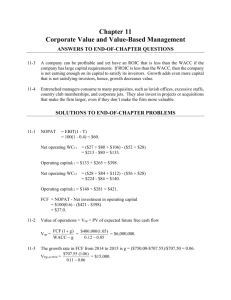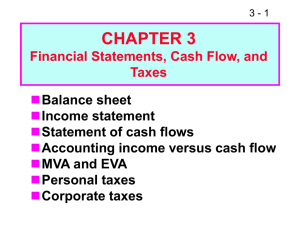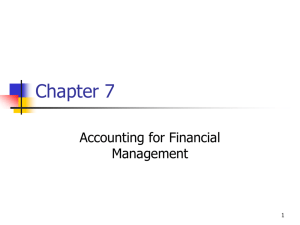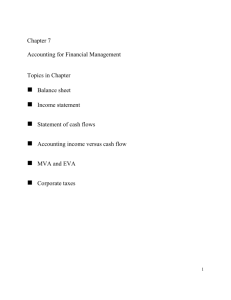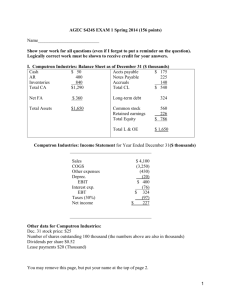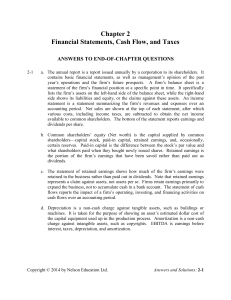MINI CASE – Financial Statements
advertisement
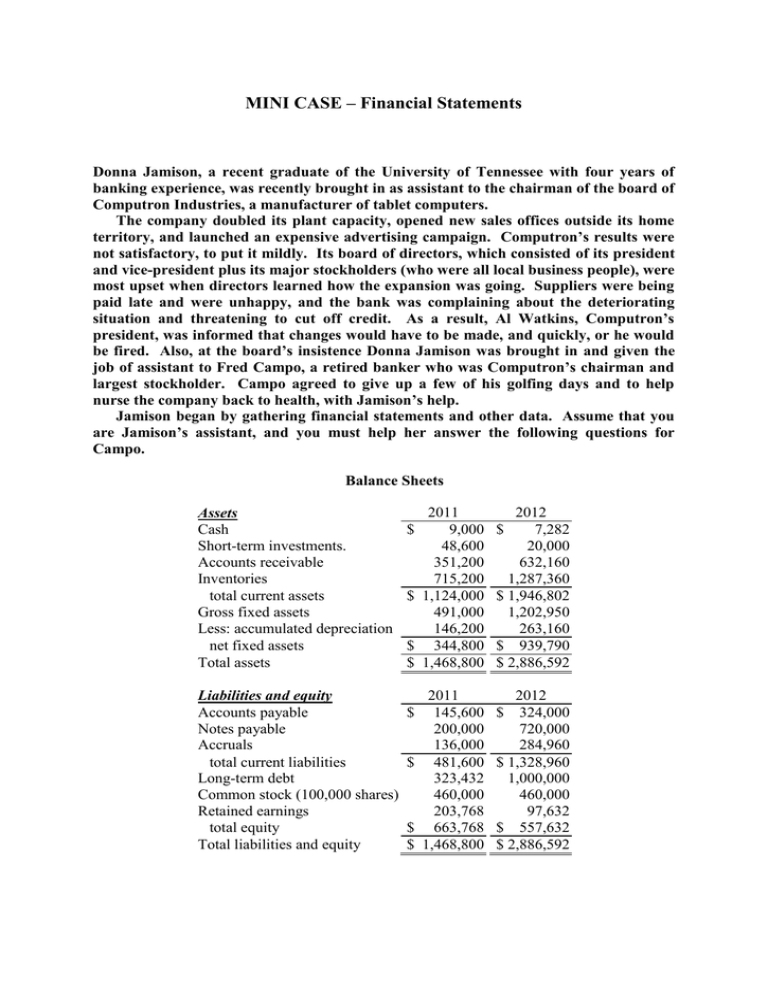
MINI CASE – Financial Statements Donna Jamison, a recent graduate of the University of Tennessee with four years of banking experience, was recently brought in as assistant to the chairman of the board of Computron Industries, a manufacturer of tablet computers. The company doubled its plant capacity, opened new sales offices outside its home territory, and launched an expensive advertising campaign. Computron’s results were not satisfactory, to put it mildly. Its board of directors, which consisted of its president and vice-president plus its major stockholders (who were all local business people), were most upset when directors learned how the expansion was going. Suppliers were being paid late and were unhappy, and the bank was complaining about the deteriorating situation and threatening to cut off credit. As a result, Al Watkins, Computron’s president, was informed that changes would have to be made, and quickly, or he would be fired. Also, at the board’s insistence Donna Jamison was brought in and given the job of assistant to Fred Campo, a retired banker who was Computron’s chairman and largest stockholder. Campo agreed to give up a few of his golfing days and to help nurse the company back to health, with Jamison’s help. Jamison began by gathering financial statements and other data. Assume that you are Jamison’s assistant, and you must help her answer the following questions for Campo. Balance Sheets Assets Cash Short-term investments. Accounts receivable Inventories total current assets Gross fixed assets Less: accumulated depreciation net fixed assets Total assets Liabilities and equity Accounts payable Notes payable Accruals total current liabilities Long-term debt Common stock (100,000 shares) Retained earnings total equity Total liabilities and equity $ $ $ $ 2011 9,000 48,600 351,200 715,200 1,124,000 491,000 146,200 344,800 1,468,800 2011 145,600 200,000 136,000 $ 481,600 323,432 460,000 203,768 $ 663,768 $ 1,468,800 $ 2012 $ 7,282 20,000 632,160 1,287,360 $ 1,946,802 1,202,950 263,160 $ 939,790 $ 2,886,592 2012 324,000 720,000 284,960 $ 1,328,960 1,000,000 460,000 97,632 $ 557,632 $ 2,886,592 $ Income Statements 2011 Sales $ 3,432,000 Cost of goods sold 2,864,000 Other expenses 340,000 Depreciation 18,900 total operating costs $ 3,222,900 EBIT $ 209,100 Interest expense 62,500 EBT $ 146,600 Taxes (40%) 58,640 Net income $ 87,960 Other data Stock price Shares outstanding EPS DPS 2012 $ 5,834,400 4,980,000 720,000 116,960 $ 5,816,960 $ 17,440 176,000 $ (158,560) (63,424) $ (95,136) 2011 2012 8.50 $ 6.00 100,000 100,000 $ 0.880 $ (0.951) $ 0.220 $ 0.110 $ Statement of retained earnings, 2012 Balance of retained earnings, 12/31/2011 add: net income, 2012 less: dividend paid, 2012 Balance of retained earnings, 12/31/2012 $ 203,768 $ (95,136) $ (11,000) $ 97,632 Statement of Cash Flows Operating activities Net income $ (95,136) Adjustments: noncash adjustments: depreciation 116,960 changes in working capital: change in accounts receivable (280,960) change in inventories (572,160) change in accounts payable 178,400 change in accruals 148,960 Net cash provided by operating activities $ (503,936) Long-term investing activities Cash used to acquire fixed assets $ (711,950) Financing activities change in short term investments change in notes payable change in long-term debt change in common stock payment of cash dividends Net cash provided by financing activities $ 28,600 $ 520,000 $ 676,568 $ $ (11,000) $ 1,214,168 Summary Net change in cash Cash at beginning of year Cash at end of year $ $ (1,718) 9,000 7,282 a. What effect did the expansion have on sales and net income? What effect did the expansion have on the asset side of the balance sheet? What effect did it have on liabilities and equity? b. What do you conclude from the statement of cash flows? c. What is free cash flow? Why is it important? What are the five uses of FCF? d. What are Computron’s net operating profit after taxes (NOPAT) and free cash flow (FCF)? ANSWER: NOPAT = EBIT(1 - TAX RATE) NOPAT12 = $17,440(1 - 0.4) = $10,464. NOPAT11 = $125,460. FCF f. = NOPAT - NET INVESTMENT IN CAPITAL = $10,464 - ($2,257,632 - $1,138,600) = $10,464 - $1,119,032 = -$1,108,568. Calculate Computron’s return on invested capital. Computron has a 10% cost of capital (WACC). Do you think Computron’s growth added value? ANSWER: ROIC = NOPAT / TOTAL NET OPERATING CAPITAL. ROIC12 = $10,464 / $2,257,632 = 0.5%. ROIC11 = 11.0%. The ROIC of 0.5% is less than the WACC of 10%. Investors did not get the return they require. Note: high growth usually causes negative FCF (due to investment in capital), but that’s ok if ROIC > WACC. For example, home depot has high growth, negative FCF, but a high ROIC. g. Jamison also has asked you to estimate Computron's EVA. She estimates that the after-tax cost of capital was 10 percent in both years. Please note the following: EVA stands for Economic Value Added EVA =( Net Operating Profit After Taxes) Less (Cost of Capital x Net Operating Capital) EVA = NOPAT – WACC x CAPITAL h. What happened to Computron's market value added (MVA)? Please note: Market Value Added = Market Value of the Firm Less the Book Value of the Firm Market Value of the firm = Market Value of the Outstanding Stock Less and the Market Value of the Outstanding Debt (Eg. Bonds) Book Value of the Firm = The value of the Equity and Debt shown on the Balance Sheet. If the book value of the debt is equal to the market value if the debt, then the MVA = The market value of the equity – the book value of the equity.
